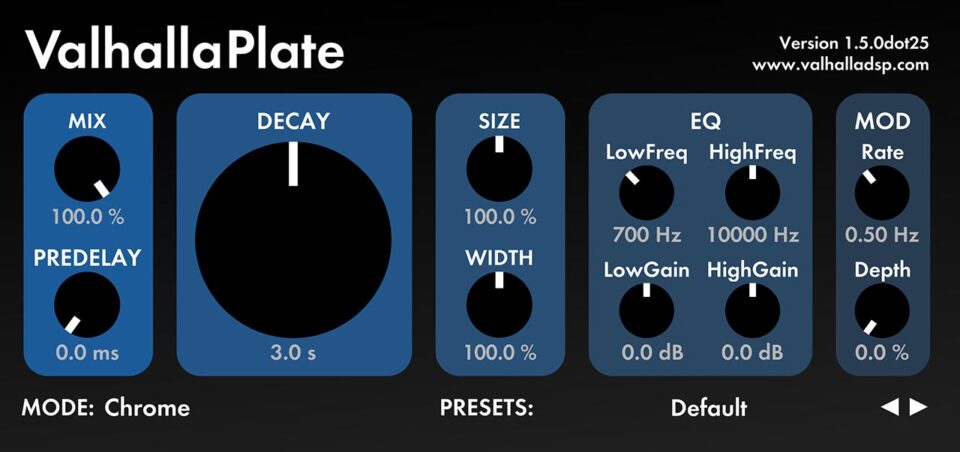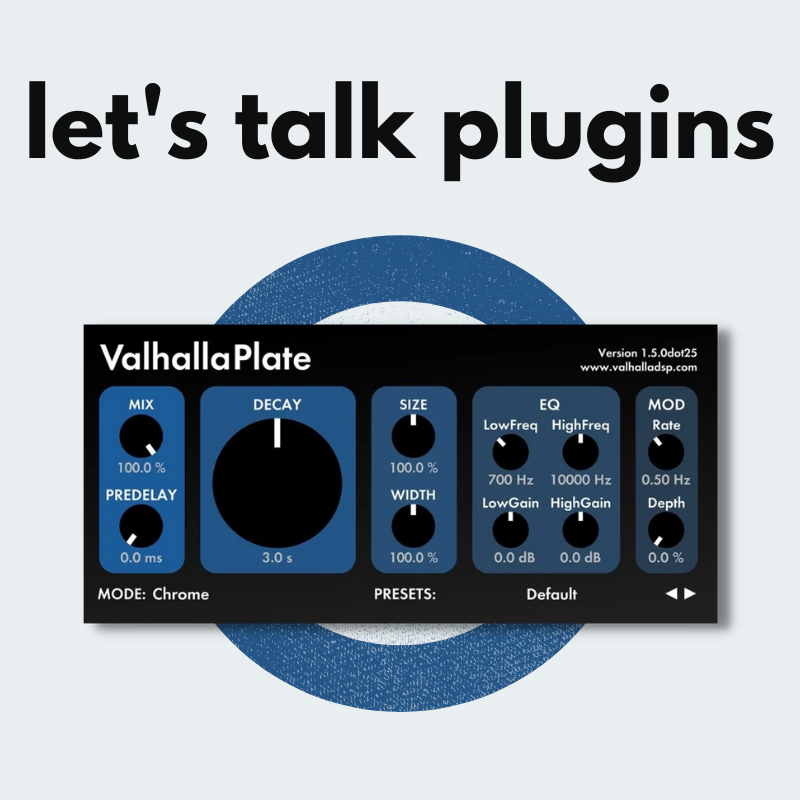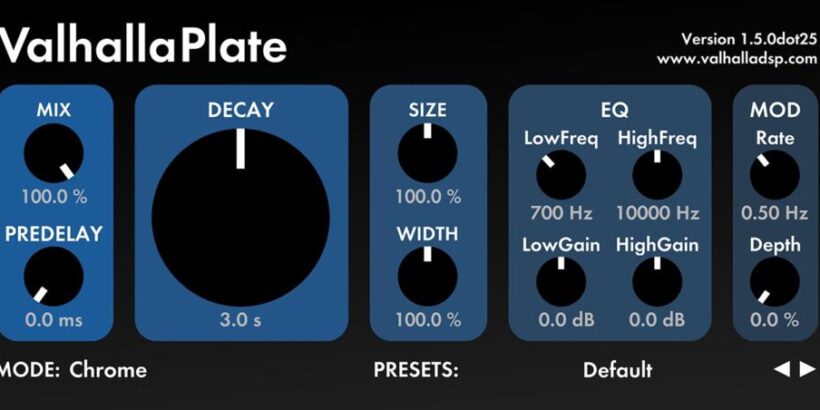Valhalla Plate Crack + Product Key

Valhalla Plate Crack is our algorithmic take on the classic plate reverb sound. Twelve original algorithms emulate the sound and behavior of real steel plate reverb, taking the sound to dimensions that physical plates cannot match. Plate reverbs have been a passion of mine for a long time. As a reverb developer, the physics of discs is fascinating. The physical structure of a plate reverb is quite simple if a bit strange: a thin sheet of steel is suspended by springs in a metal frame,
The input signal is transmitted to the plate through of a transducer and the output signal is taken directly from microphones attached to the plate. The behavior of plate reverbs is complex and wonderful: instant onset of reverb Instant High Echo DensityDispersion (the speed of sound is different in a panel for different frequencies, with high frequencies moving faster than low frequencies) A complex frequency/decay curve where low frequencies can decay MUCH longer or shorter than mid frequencies, and high frequencies always have a fairly short decay.
You may also like this VPS Avenger Crack
Valhalla Plate Crack Features
- More importantly, I like the sound of the records. Plate reverbs are often associated with the 1960s, but they were widely used in the 1970s and 80s and are still in use today.
- Contrary to popular belief, a well-tuned plate reverb does not sound metallic and is not particularly bright.
- The reverb/decay frequency curve works on just about any source material, from guitars to vocals to drums and just about anything.
- A few years ago I became obsessed with the vocal sound of early Fleet Foxes records.
- Turns out an Avast Recording Company EMT140 recording was used for these recordings here in North Seattle.
- The vocal reverb on these Fleet Foxes recordings is reminiscent of many 1960s recordings, but with pushed levels and decay times: I’ve mentally kept plate reverbs on the back burner for the past few years.
- I’ve read every article I could find on the subject, searched for saved examples of slabs, and put all the slab-like artifacts in my algorithmic experiments into a folder to come back to later.
- With the recent major website redesign complete, I was able to start working in earnest on prototype plate reverbs Valhalla Plate Activation Key.
- Going to Avast Recording with Don Gunn and spending the day working with the EMT140 I was listening to on vinyl was one of the most exciting days of my career.
Valhalla Plate Crack System Requirements
- After years of R&D and nearly a year of dedicated programming, ValhallaPlate is finally available to the public.
- Over the next few weeks I will be posting several blog posts detailing the history of plate reverb, the physics and psychophysics of plates, and how I applied the research to the design of ValhallaPlate.
- For now, you can head over to the ValhallaPlate site, download the demos, and listen to the results for yourself.
- ValhallaPlate was designed from the ground up to be easy to use and sound great with virtually any parameter setting.
- It’s a natural consequence of being inspired by plate reverbs.
- An EMT140 would typically have between 1 and 2 parameters (decay time and sometimes a high pass filter on the drive input jack).
- The goal of ValhallaPlate was to expand the possibilities of physical discs while maintaining the simplicity of discs.
- MIX: Your standard wet/dry mix, where 0% is a dry signal, 100% is reverb only, and 50% is an equal mix between the two. The mix control uses the standard sine/cosine crossfade law that all my plugins use.

What’s new Valhalla Plate Crack
- Click on the word “MIX” above the MIX control to set the MIX to a specific value.
- This is useful when browsing presets or using ValhallaPlate as a send.
- It was designed to be used as a send, by the way.
- The sends are AWESOME for the reverbs. PRE DELAY: A stereo pre-delay, before the plate patterns.
- The time is in milliseconds and the fader is distorted for better control of shorter delays. DECAY: The beating heart of the plugin Valhalla Plate Product Key.
- This controls the average decay time, which is set differently for different reverb modes.
- This is an accurate measurement of the RT60 between 2.9 kHz and 3.6 kHz. Below this frequency, the decay time is either shorter or longer.
- A quick rule of thumb: high frequencies tend to have a fairly short decay setting, regardless of the DECAY setting.
- Short DECAY settings have shorter high frequency decay times, but once you get DECAY settings > 3 seconds, the high frequency decay time tends to stay fixed.
- Here too, different modes have different decay behavior at high frequencies.
How to install it?
- The DECAY control has been distorted in such a way that most of the control range covers “typical” record decay processes, ie.
- H between approximately 0.5 and 6 seconds. The last 25% of knob travel allows for much longer decay times than a physical recording.
- It’s probably not physically correct, but whatever. Sounds cool. SIZE: Controls the “size” of the disk in arbitrary units. Specifically, it controls the modal density of the disk.
- Smaller sizes (between 0% and 100%) produce a more metallic sound typical of physical discs.
- Larger sizes (>100%) allow you to have a much higher mode density than a typical recording, which can produce a “softer” or “brighter” reverb sound.
- WIDTH: Adjusts the stereo output width of the reverb. 100% is a typical plate reverb with each pickup going to a separate output channel.
- 0% mixes the left and right outputs together and sends them to the left and right output channels.
- To be honest, I find it a bit strange, but WIDTH settings < 100% can be useful to create a smaller stereo image.
- WIDTH settings > 100% increase the perceived width of the image.
- This is not a traditional M/S matrix – the WIDTH control has been optimized for reverb signals.
Conclusion
It should be noted that the equalization of ValhallaPlate changes with the DECAY setting. This is found in real physical disks. The overall EQ is different for each of the reverb modes, with different modes having more or less brightness of their own. Also, the EQ filters are not built into the reverb algorithm itself, so the settings of these filters do not affect the decay of the reverb. MOD Rate: Controls the rate in Hertz of the low frequency modulation of the reverb. This is a chorus-like modulation, but more subtle than what I’ve used on previous Reverb models Valhalla Plate Serial Key.
The purpose of modulation is to reduce metallic artifacts without introducing obvious pitch changes or chorusing effects in the output signal. I tend to set it between 0.2Hz and 0.5Hz, but values up to 2Hz are useful for creating big synth reverbs. MOD Depth: Controls the depth of the reverb modulation. For realistic physical disks, this should be set to 0%. Turning it up removes a lot of the “metal” from the record, which can be good for more general reverb applications.
